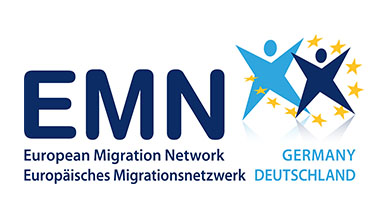The Application of the Temporary Protection Directive to Refugees from Ukraine in Germany , , Study by the German national contact point for the European Migration Network (EMN)
 Source: BAMF (cover image: AdobeStock | New Africa)
Source: BAMF (cover image: AdobeStock | New Africa)
This national study investigates best practices and challenges in the application of the EU Temporary Protection Directive for refugees from Ukraine in Germany.
On March 4, 2022, the European Council activated Directive EU Directive 2001/55/EC on minimum standards for giving temporary protection to refugees in response to the Russian war of aggression against Ukraine and the resulting movement of people. This Directive enables the admission of refugees without individual case assessment as in the asylum procedure. As a result, over 1.1 million Ukrainian refugees have been registered in Germany to date. This study analyses the legal and administrative implementation of the Directive in Germany, access to the rights granted under the Directive, as well as best practices. Additionally, the study examines how state actors have been dealing with challenges in connection with the implementation of the Directive.
Arrival: Registration and Distribution
While previously established procedures such as registration at PIK stations are in use, new measures such as the FREE distribution platform have also been implemented. This enables the precise registration of refugees and improved distribution procedures, as aspects such as the availability of housing and social ties are now also considered.
Particularly Vulnerable Groups: Protection of Minors, Protection against Human Trafficking and Exploitation
In the course of the flight from Ukraine, almost 5,000 minors have arrived unaccompanied by their parents, but often with relatives. The main challenge for the authorities is to clarify existing custody relationships from Ukraine and to recognise them under German law, taking into consideration the best interests of the child. In the area of human trafficking, there was no significant increase in the number of reported cases, which is attributed to the secure legal status under temporary protection and extensive awareness-raising campaigns.
Mobility of Ukrainian Refugees
The Temporary Protection Registration Platform (TPP) was created to ensure the free mobility of refugees within the European Union and to prevent abuse of benefits through double registrations. However, there is still a dark field in the area of temporary and permanent return to Ukraine, which is soon to be tackled by an improvement in data exchange between the immigration and benefits authorities.
Accommodation and Housing Situation
Ukrainian refugees with a residence permit in accordance with Section 24 (1) AufenthG are generally subject to a residence regulation in accordance with Section 12a AufenthG. Supported by government measures, private accommodation plays a key role in providing housing. Despite the tight housing market, around 79 percent of Ukrainian refugees are housed in private accommodation.
Labour Market Participation and Access to Social Benefits
Persons entitled to protection from Ukraine have full access to the labour market and receive benefits in accordance with SGB II and SGB XII. The employment rate of Ukrainian refugees rose to 19 percent in summer 2023 compared to 14.6 percent in 2022. Measures such as the "Turbo for Labour Market Integration" action plan aim to integrate refugees into the labour market more quickly.
Access to the Education System
Over 210,000 Ukrainian pupils attended German schools in September 2023. In addition to integration into regular schools, Ukrainian teachers and school materials as well as online participation in Ukrainian remote learning are made available and facilitate further schooling to prepare for a possible return to Ukraine. Refugee students from Ukraine easier than other access to the German higher education system.
Change to Other Residence Permits
Despite increasing integration, only few registered Ukrainian refugees have made the transition to other residence permits so far. This raises the question on how to organise these transitions in view of the imminent expiry of the directive in March 2025. It is important to organise the transition at an early stage in order to ensure planning security for both the authorities and the refugees.
The study was written by Philipp Heiermann and Kaan Atanisev.
This download is available in other languages, too.
Citation
Heiermann, P. & Atanisev, K. (2024). The Application of the Temporary Protection Directive to Refugees from Ukraine in Germany (EMN Germany Paper 1/2024). Nuremberg. Federal Office for Migration and Refugees.
https://doi.org/10.48570/bamf.fz.emndp.01/2024.en.2024.rlschutzukr.1.0
